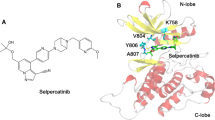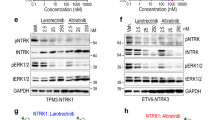Abstract
Targeted drug therapies represent a therapeutic breakthrough in the treatment of human cancer. However, the emergence of acquired resistance inevitably compromises therapeutic drugs. Rearranged during transfection (RET) proto-oncogene, which encodes a receptor tyrosine kinase, is a target for several kinds of human cancer such as thyroid, breast, and colorectal carcinoma. A single mutation L881V at the RET kinase domain was found in familial medullary thyroid carcinoma. Nintedanib can effectively inhibit the RET L881V mutant, whereas its analog compound 1 is unable to combat this mutant. However, the underlying mechanism was still unexplored. Here, molecular dynamics (MD) simulations, binding free energy calculations, and structural analysis were performed to uncover the mechanism of overcoming the resistance of RET L881V mutant to nintedanib. Energetic analysis revealed that the L881V mutant remained sensitive to the treatment of nintedanib, whereas it was insensitive to the compound 1. Structural analysis further showed that the distribution of K758, D892, and N879 network had a detrimental effect on the binding of compound 1 to the L881V mutant. The obtained results may provide insight into the mechanism of overcoming resistance in the RET kinase.








Similar content being viewed by others
Data availability
The relevant data are available from the corresponding author upon reasonable request.
Code availability
N/A.
References
Roskoski R (2021) Properties of FDA-approved small molecule protein kinase inhibitors: A 2021 update. Pharmacol Res 165:105463
Ding C, Song Z, Shen A et al (2020) Small molecules targeting the innate immune cGAS-STING-TBK1 signaling pathway. Acta Pharm Sin B 10:2272–2298
Ward RA, Fawell S, Floc’h N, et al (2020) Challenges and opportunities in Cancer Drug Resistance. Chem Rev 121:3297–3351
Ni D, Li Y, Qiu Y et al (2020) Combining allosteric and orthosteric drugs to overcome drug resistance. Trends Pharmacol Sci 41:336–348
Lu S, Qiu Y, Ni D et al (2020) Emergence of allosteric drug-resistance mutations: new challenges for allosteric drug discovery. Drug Discov Today 25:177–184
Jiang L, Wang Y, Li Q et al (2021) Design, synthesis, and biological evaluation of Bcr-Abl PROTACs to overcome T315I mutation. Acta Pharm Sin B 11:1315–1328
Kong X, Pan P, Sun H et al (2019) Drug discovery targeting anaplastic lymphoma kinase (ALK). J Med Chem 62:10927–10954
Jia Y, Yun C-H, Park E et al (2016) Overcoming EGFR(T790M) and EGFR(C797S) resistance with mutant-selective allosteric inhibitors. Nature 534:129–132
Duong MTH, Lee J-H, Ahn H-C (2020) C-Jun N-terminal kinase inhibitors: structural insight into kinase-inhibitor complexes. Comput Struct Biotechnol J 18:1440–1457
Salvatore D, Santoro M, Schlumberger M (2021) The importance of the RET gene in thyroid cancer and therapeutic implications. Nat Rev Endocrinol 17:296–306
Li AY, McCusker MG, Russo A et al (2019) RET fusions in solid tumors. Cancer Treat Rev 81:101911
Liu X, Shen T, Mooers BHM et al (2018) Drug resistance profiles of mutations in the RET kinase domain. Br J Pharmacol 175:3504–3515
Moccia M, Frett B, Zhang L et al (2020) Bioisosteric discovery of npa101.3, a second-generation ret/vegfr2 inhibitor optimized for single-agent polypharmacology. J Med Chem 63:4506–4516
Yuan K, Wang X, Dong H et al (2021) Selective inhibition of CDK4/6: a safe and effective strategy for developing anticancer drugs. Acta Pharm Sin B 11:30–54
Terzyan SS, Shen T, Liu X et al (2019) Structural basis of resistance of mutant RET protein-tyrosine kinase to its inhibitors nintedanib and vandetanib. J Biol Chem 294:10428–10437
Ravindranath PA, Forli S, Goodsell DS et al (2015) AutoDockFR: advances in Protein-ligand docking with explicitly specified binding site flexibility. PLOS Comput Biol 11:e1004586
Leonard AN, Wang E, Monje-Galvan V, Klauda JB (2019) Developing and testing of lipid force fields with applications to modeling cellular membranes. Chem Rev 119:6227–6269
Case DA, Cheatham TE, Darden T et al (2005) The Amber biomolecular simulation programs. J Comput Chem 26:1668–1688
Wang J, Wolf RM, Caldwell JW et al (2004) Development and testing of a general amber force field. J Comput Chem 25:1157–1174
Jorgensen WL, Chandrasekhar J, Madura JD et al (1983) Comparison of simple potential functions for simulating liquid water. J Chem Phys 79:926
Wang Y, Ji D, Lei C et al (2021) Mechanistic insights into the effect of phosphorylation on Ras conformational dynamics and its interactions with cell signaling proteins. Comput Struct Biotechnol J 19:1184–1199
He X, Huang N, Qiu Y et al (2021) Conformational selection mechanism provides structural insights into the optimization of APC-asef inhibitors. Molecules 26:962
Lu S, He X, Yang Z et al (2021) Activation pathway of a G protein-coupled receptor uncovers conformational intermediates as targets for allosteric drug design. Nat Commun 12:4721
Navarro G, Gonzalez A, Campanacci S et al (2020) Experimental and computational analysis of biased agonism on full-length and a C-terminally truncated adenosine A2A receptor. Comput Struct Biotechnol J 18:2723–2732
Liang Z, Zhu Y, Long J et al (2020) Both intra and inter-domain interactions define the intrinsic dynamics and allosteric mechanism in DNMT1s. Comput Struct Biotechnol J 18:749–764
Wu X, Brooks BR (2003) Self-guided Langevin dynamics simulation method. Chem Phys Lett 381:512–518
Lu S, Ni D, Wang C et al (2019) Deactivation pathway of Ras GTPase underlies conformational substates as targets for drug design. ACS Catal 9:7188–7196
Ni D, Wei J, He X et al (2021) Discovery of cryptic allosteric sites using reversed allosteric communication by a combined computational and experimental strategy. Chem Sci 12:464–476
Darden T, York D, Pedersen L (1993) Particle mesh Ewald: an N.long(N)method for Ewald sums in large systems. J Chem Phys 98:10089–10092
Ryckaert JP, Ciccotti G, Berendsen HJC (1977) Numerical integration of the cartesian equations of motion of a system with constraints: molecular dynamics of n-alkanes. J Comput Phys 23:327–341
Feng L, Lu S, Zheng Z et al (2021) Identification of an allosteric hotspot for additive activation of PPARγ in antidiabetic effects. Sci Bull 66:1559–1570
Lu S, Chen Y, Wei J et al (2021) Mechanism of allosteric activation of SIRT6 revealed by the action of rationally designed activators. Acta Pharm Sin B 11:1355–1361
Shi Y, Zhang X, Mu K et al (2020) D3Targets-2019-nCoV: a webserver for predicting drug targets and for multi-target and multi-site based virtual screening against COVID-19. Acta Pharm Sin B 10:1239–1248
Jang H, Zhang M, Nussinov R (2020) The quaternary assembly of KRas4B with Raf-1 at the membrane. Comput Struct Biotechnol J 18:737–748
Roe DR, Cheatham TE (2013) PTRAJ and CPPTRAJ: software for processing and analysis of molecular dynamics trajectory data. J Chem Theory Comput 9:3084–3095
Wang E, Sun H, Wang J et al (2019) End-point binding free energy calculation with MM/PBSA and MM/GBSA: strategies and applications in drug design. Chem Rev 119:9478–9508
Xie T, Yu J, Fu W et al (2019) Insight into the selective binding mechanism of DNMT1 and DNMT3A inhibitors: a molecular simulation study. Phys Chem Chem Phys 21:12931–12947
Li X, Dai J, Ni D et al (2020) Insight into the mechanism of allosteric activation of PI3Kα by oncoprotein K-Ras4B. Int J Biol Macromol 144:643–655
Li X, Ye M, Wang Y, et al (2020) How does Parkinson’s disease-related mutations disrupt the dimerization of WD40 domain in LRRK2: Phys Chem Chem Phys 20421–20433.
Hou T, Wang J, Li Y, Wang W (2011) Assessing the performance of the MM/PBSA and MM/GBSA methods. 1. The accuracy of binding free energy calculations based on molecular dynamics simulations. J Chem Inf Model 51:69–82
Zhang Q, Chen Y, Ni D et al (2021) Targeting a cryptic allosteric site of SIRT6 with small-molecule inhibitors that inhibit the migration of pancreatic cancer cells. Acta Pharm Sin B. https://doi.org/10.1016/j.apsb.2021.06.015
Wang Y, Gao J, Zhao S et al (2020) Discovery of 4-arylthiophene-3-carboxylic acid as inhibitor of ANO1 and its effect as analgesic agent. Acta Pharm Sin B 11:1947–1964
Qiu Y, Yin X, Li X et al (2021) Untangling dual-targeting therapeutic mechanism of epidermal growth factor receptor (EGFR) based on reversed allosteric communication. Pharmaceutics 13:747
Lu S, Zhang J (2019) Small-molecule allosteric modulators of G-protein-coupled receptors: drug-target interactions. J Med Chem 62:24–45
Lu S, Shen Q, Zhang J (2019) Allosteric methods and their applications: facilitating the discovery of allosteric drugs and the investigation of allosteric mechanisms. Acc Chem Res 52:492–500
Lu S, He X, Ni D et al (2019) Allosteric modulator discovery: from serendipity to structure-based design. J Med Chem 62:6405–6421
Mahalapbutr P, Kongtaworn N, Rungrotmongkol T (2020) Structural insight into the recognition of S-adenosyl-L-homocryteine and sinefungin in SARS-CoV-2 Nsp16/Nsp10 RNA cap 2’-O-methyltransferase. Comput Struct Biotechnol J 18:2757–2765
Wang B, Peng F, Huang W et al (2020) Rational drug design, synthesis, and biological evaluation of novel chiral tetrahydronaphthalene-fused spirooxindole as MDM2-CDK4 dual inhibitor against glioblastoma. Acta Pharm Sin B 10:1492–1510
Ji M, Ding Y, Li X et al (2019) Computational investigation of a ternary model of SnoN-SMAD3-SMAD4 complex. Comput Biol Chem 83:107159
Shah M, Ahmad B, Choi S et al (2020) Mutations in the SARS-CoV-2 spike RBD are responsible for stronger ACE2 binding and poor anti-SARS-CoV mAbs corss-neutralization. Comput Struct Biotechnol J 18:3402–3414
Liu X, Tian W, Cheng J et al (2020) Microsecond molecular dynamics simulations reveal the allosteric regulatory mechanism of p53 R249S mutation in p53-associated liver cancer. Comput Biol Chem 84:107194
Zheng G, Xu S, Liu W et al (2021) Deciphering the resistance mechanism of RET kinase mutant against vandetanib and nintedanib using molecular dynamics simulations. J Exp Nanosci 16:279–294
Gogoi P, Kanaujia SP (2019) Role of structural features in oligomerization, active-site integrity and ligand binding of ribose-1,5-bisphosphate isomerase. Comput Struct Biotechnol J 17:333–344
Xing J, Mei H, Huang S, Zhang D, Pan X (2019) An energetically favorable ligand entrance gate of a multidrug transporter revealed by partial nudged elastic band simulations. Comput Struct Biotechnol J 17:319–323
Acknowledgements
The authors highly thank the Supercomputer Center at Wuhan University for providing computational resources.
Author information
Authors and Affiliations
Contributions
SC, XJ, CT, MF, and WX performed molecular docking and MD simulations and wrote the manuscript. JL and DJ revised the manuscript.
Corresponding authors
Ethics declarations
Competing interests
The authors declare no competing interests.
Additional information
Publisher's note
Springer Nature remains neutral with regard to jurisdictional claims in published maps and institutional affiliations.
Shu Cao and Xu Jiang contributed equally to this work.
Rights and permissions
About this article
Cite this article
Cao, S., Jiang, X., Tan, C. et al. How does nintedanib overcome cancer drug-resistant mutation of RET protein-tyrosine kinase: insights from molecular dynamics simulations. J Mol Model 27, 337 (2021). https://doi.org/10.1007/s00894-021-04964-1
Received:
Accepted:
Published:
DOI: https://doi.org/10.1007/s00894-021-04964-1




